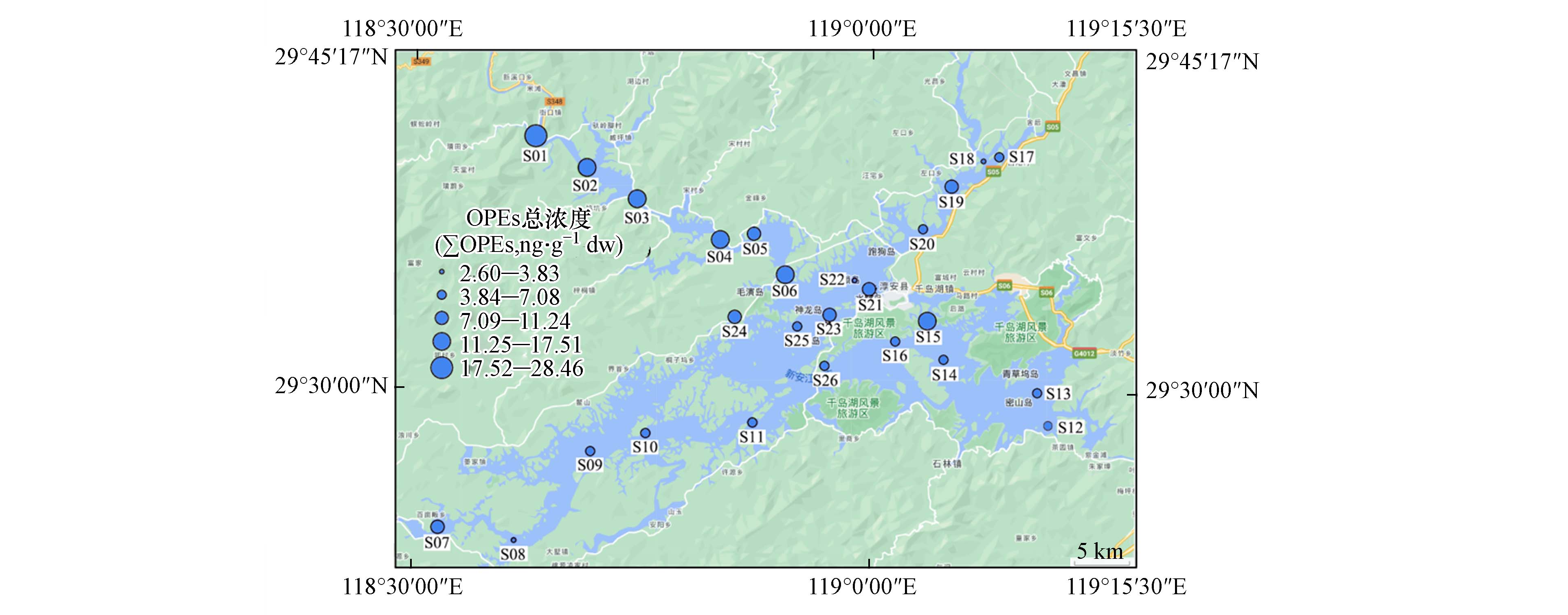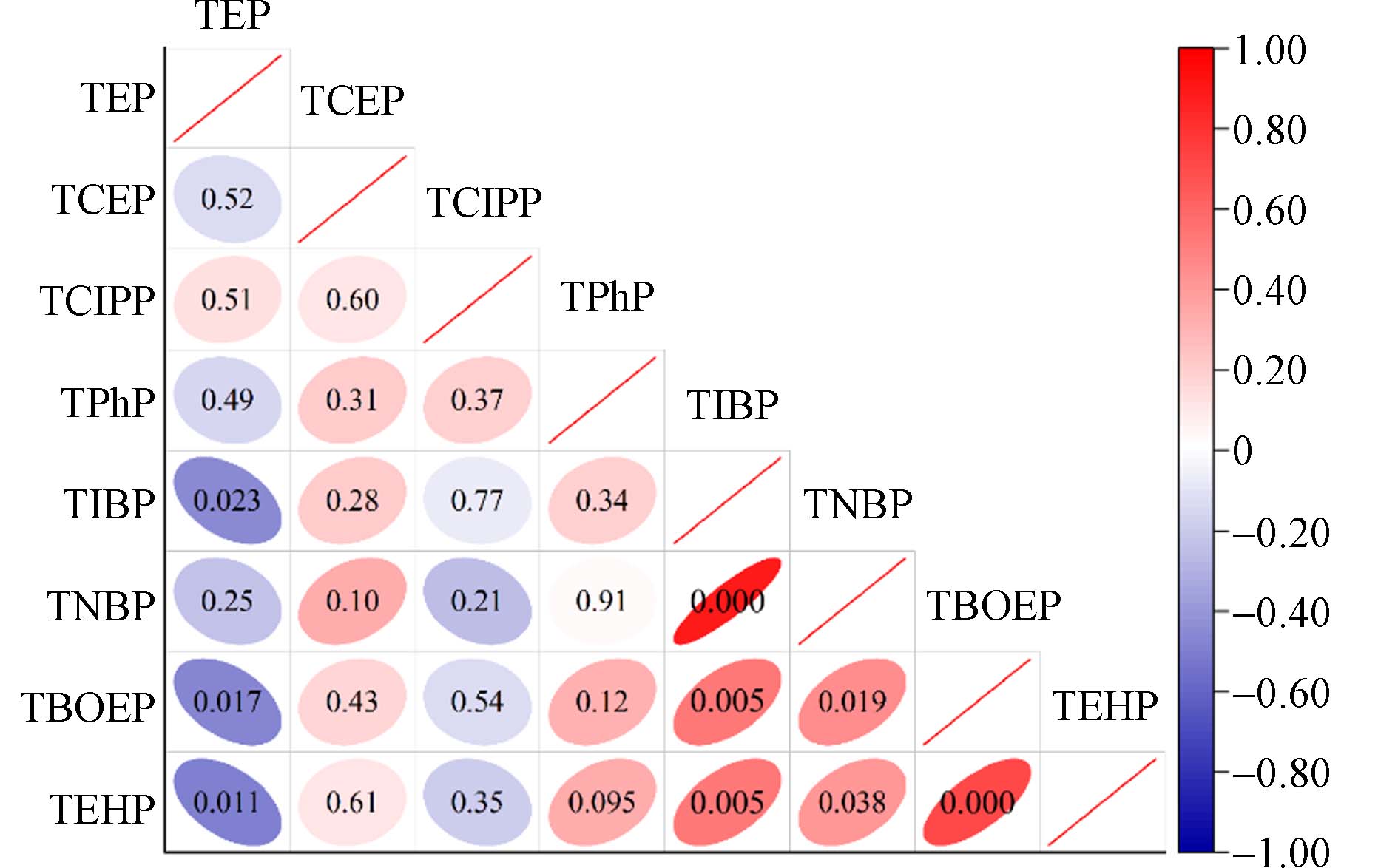-
有机磷酸酯(OPEs)主要作为阻燃剂和增塑剂被广泛应用于纺织品、塑料、电子元器件等产品中[1]. 近年来多溴二苯醚(PBDEs)和六溴环十二烷(HBCD)等传统溴代阻燃剂相继被列入斯德哥尔摩公约,生产使用受到管控,促使OPEs类阻燃剂的全球产量逐年上升,目前已从2001年的18.6万吨上涨到2018年的100万吨[2 − 3]. OPEs作为一类广泛应用的添加剂,其与应用的产品之间没有化学键合作用,容易在使用、废弃和处置等过程中以挥发、泄露或磨损等方式向周边环境释放[4]. 目前,已在全球各类环境介质和生物体中广泛检测到OPEs的存在[5 − 6],并且一些OPEs被证明具有致癌性、神经毒性、生殖和发育毒性及内分泌干扰效应[7]. 三(2-氯乙基)磷酸酯(TCEP)和异丙基化磷酸三苯酯(IPPP)已被列入了我国优先控制化学品名录[8].
沉积物通常被认为是有机污染物重要的汇,几十年来,开放水域的沉积物一直是科研工作者们的研究热点,用以解析污染物的来源和环境行为及潜在生态风险. OPEs可以通过工业/生活废水排放和大气干/湿沉降等多种途径进入水体,目前已在全球水体中广泛检出[9]. 关于沉积物中OPEs的研究目前主要聚焦于河流和海洋水体中[9 − 10]. 全球河流和海洋沉积物中∑OPEs的平均浓度范围为几ng·g−1 至数百ng·g−1干重(dry weight, dw)[9, 11]. 值得关注的是,在美国旧金山湾[12]和欧洲多个国家的养殖海域[13]沉积物中∑OPEs的浓度水平普遍高于同期测得的∑PBDEs 的浓度. 目前关于湖泊沉积物中OPEs的研究相对缺乏,只有少数研究者报道了美国五大湖水域和我国太湖及洞庭湖水域沉积物中OPEs的赋存状况.
千岛湖(又名新安江水库)是我国华东地区最大的人工淡水湖和最重要的饮用水源地之一,其水质安全不仅影响水生生态环境,也对上千万饮用千岛湖湖水居民的身体健康具有重要影响. 然而,对于千岛湖水域污染物的研究目前仅关注于常规水质指标和传统持久性有机污染物[14],对于该水域中可能存在的OPEs等新污染物的赋存和来源及潜在风险的研究仍未见报道. 因此,本研究对千岛湖沉积物中16种OPEs赋存特征和空间分布进行了分析,并解析了污染来源,评估了潜在的生态风险,有助于摸清千岛湖水域OPEs类新污染物的污染底数,从而为千岛湖水域新污染物治理与管控提供基础数据.
-
本研究分析了16种OPEs. 7种OPEs自然标准品,包括磷酸三(2-氯乙基)酯(TCEP)、磷酸三(2-氯异丙基)酯(TCIPP)、磷酸三(1,3-二氯-2-丙基)酯(TDCIPP)、磷酸三乙基酯(TEP)、磷酸三正丙基酯(TPrP)、磷酸三正丁基酯(TNBP)和磷酸三苯基酯(TPhP)购自Cambridge Isotope Laboratories(Andover,MA,USA),化学纯度均为98%. 6种OPEs自然标准品,包括磷酸三(2-丁氧基乙基)酯(TBOEP)、磷酸三(2-乙基己基)酯(TEHP)、磷酸二乙基己基二苯基酯(EHDPP)、磷酸三-邻甲苯基酯(TOTP)、磷酸三-间甲苯基酯(TMTP)和磷酸三-对甲苯基酯(TPTP)购自Wellington Laboratories(Guelph, ON, Canada),化学纯度为98%. 磷酸三甲基酯(TMP, 纯度98.5%)和磷酸甲苯基-二苯基酯(CDPP, Tech Mix)购自AccuStandard Inc.(New Haven, CT);磷酸三-异丁基酯(TIBP, 纯度95%)购自J&K Scientific(中国北京). 7种化学纯度为98%的氘代同位素OPEs内标,包括TCEP-d12、TCIPP-d18、TDCIPP-d15、TEP-d15、TPrP-d21、TNBP-d27和TPhP-d15购自Cambridge Isotope Laboratorie(Andover, MA, USA). 2种化学纯度为98%的氘代同位素OPEs内标,包括TPTP-d21和TEHP-d51购自Toronto Research Chemicals(Toronto, ON, Canada).
LC-MS级甲醇和乙腈购自于Fisher Scientific(Fair Lawn,NJ,USA). 纯度为99%的HPLC级甲酸购自于Dikma Technologies Inc.(Lake Forest, CA, USA). 实验用超纯水(18.3 MΩ·cm)使用Milli-Q超纯梯度系统(Millipore, Bedford, MA)进行制备. Supelclean伯-仲胺(PSA, 38—75 μm)分散固相萃取(d-SPE)吸附剂购自于Supelco Analytical.
-
千岛湖位于北纬29°11′至30°02′,东经118°34′至119°15′之间,属亚热带季风气候,是我国第四大水库,库容量达178.4亿m3. 根据千岛湖入湖河流的流向和流量及湖区的空间分布,共设置了26个沉积物采样位点(图1). 于2023年5月,使用预清洗(乙腈:超纯水,V: V = 1: 1)的不锈钢抓斗采集沉积物样品,用铝箔包裹,然后密封在干净的密封袋中,详细的样品信息见表1. 样品采集后,于24 h内运回实验室,经冷冻干燥、研磨过筛(100目)后保存于-20 ℃ 的饮用水源地样品专用冰箱中直至分析.
-
样品前处理方法参考了本研究团队先前的研究工作[2, 15]. 称取约2 g的沉积物粉末加入到15 mL的康宁离心管中,加入9种氘代OPEs混合内标(每种绝对量均为10 ng),老化24 h. 加入5 mL乙腈/甲苯(V:V = 9:1,含0.5%甲酸)萃取液,涡旋均匀后超声辅助萃取15 min,离心5 min(
5000 r·min−1),取上清液. 超声萃取步骤重复3次,合并上清液. 使用氮吹仪在柔和的高纯氮气流下将合并后的提取液浓缩至2 mL左右,加入100 mg 吸附剂(PSA)用于净化除杂. 充分涡旋混合后在5000 r·min−1下离心5 min,收集上清液于干净的离心管中,使用氮吹仪将其浓缩至近干,然后用1 mL的甲醇复溶,置于冰箱中在4 ℃条件下保存. 上机前,在12000 r·min−1下高速离心5 min,取上清液约500 μL用于仪器分析. -
OPEs测定分析参考了本研究团队先前的研究工作[2, 15]. 简述如下:OPEs的测定分析使用超高效液相色谱-三重四极杆质谱联用仪(Vanquish Horizon UHPLC-TSQ Altis Plus MS/MS, Thermo Scientific, USA);配备了大气压电喷雾离子源(ESI)的质谱系统在正离子模式下运行,喷雾电压设定为3.5 kV;喷雾锥、喷雾毛细管和离子传输管的温度均设定为350 ℃. 氮气由氮气发生器提供,用作去溶剂化气体,高纯氩气用作碰撞气体. 质谱的二级数据采集在选择性反应监测(SRM)模式下获得,OPEs分析物的定性离子对、定量离子对、碰撞能和碰撞电压等选择性反应监测(SRM)参数列于表2.
在40 ℃下,使用Waters ACQUITY UPLC BEH C18色谱柱(内径2.1 mm×100 mm 长,颗粒厚度1.7 μm)对OPEs进行色谱分离. 以超纯水含0.1%的甲酸(A相)和甲醇含0.1%的甲酸(B相)作为二元流动相进行梯度洗脱,洗脱流速设定为0.4 mL·min−1. 梯度洗脱程序设置如下:0 min(97%A),3 min(97%A),3.5 min(0%A),8 min(0%A),9 min(97%A),11 min(97%A).
-
为防止外源污染,实验中使用的所有器具均使用色谱级的丙酮和正己烷(V: V=1:1)预清洗. 为了监控前处理过程中可能存在的流程污染,在每批次前处理样品中添加程序空白样品. 本研究报道的沉积物中OPEs的浓度为扣除程序空白之后的浓度. 对于程序空白中检出的OPEs,使用其浓度平均值加上3倍标准偏差计算方法检出限(MDL=meanblank+3SD). 对于程序空白中未检出的OPEs,基于3倍信噪比法计算仪器的检测限(IDL),并使用IDL代替MDL. 沉积物中OPEs的MDL范围为
0.0001 —0.68 ng·g−1(表2). 使用千岛湖湖中心沉积物(一式三份)作为样品基质优化方法回收率,向约2 g沉积物粉末中加入9种氘代同位素标记的OPEs内标标准品(每种10 ng)和16种OPEs未标记的自然标准品(每种10 ng)进行前处理. 千岛湖沉积物中16种OPEs的加标回收率范围为61%—103%(相对标准偏差≤11%)(表2). -
沉积物中OPEs浓度数据是否符合正态分布使用Kolmogorov−Smirnov方法检验. 通过Mann−Whitney U检验分析了不同湖区沉积物之间OPEs的浓度差异. Spearman秩相关系数分析(双尾)用于测试沉积物中OPE个体的浓度之间的相关性. 统计学显著性通过单因素方差分析模型检验,统计学显著性水平定义为P<0.05. 上述分析均使用IBM SPSS Statistics Version 16进行.
-
本研究分析的16种OPEs包含3种结构类型,分别为烷基型OPEs(TMP、TEP、TPrP、TNBP、TIBP、TBOEP和TEHP)、氯代型OPEs(TCEP、TCIPP和TDCIPP),和芳基型OPEs(TPhP、CDPP、EHDPP、TMTP、TOTP和TPTP). TMP、TPrP、CDPP和TPTP在所有表层沉积物样品中均未检出. 剩余12种OPEs在千岛湖表层沉积物中均有检出(检出率范围为3.85%—100%),其中TNBP、TIBP和TEHP及TCEP的检出率为100%,TEP、TBOEP、TCIPP和TPhP也具有较高的检出率(62%—96%),TDCIPP、TMTP、TOTP和EHDPP的检出率较低(<30%).
千岛湖表层沉积物中总OPEs(∑OPEs)浓度范围为2.6—28.5 ng·g−1干重(dry weight, dw),平均为8.8 ng·g−1dw(图1). 通常,人类活动强度大的城市或工业区湖泊沉积物中∑OPEs的平均浓度范围为几十到几百 ng·g−1dw. 如美国Ontario湖沉积物和我国江苏骆马湖沉积物中∑OPEs的平均浓度分别为16.6 [16]、21 ng·g−1dw[17];我国太湖和洞庭湖及韩国Shihwa湖沉积物中∑OPEs的平均浓度分别高达103 [18]、436 [19]、381[20] ng·g−1dw,远高于本研究千岛湖沉积物中∑OPEs的平均浓度. 然而,与受人类活动强度极小的南极海洋沉积物、北极冰川和海洋沉积物中∑OPEs的平均浓度(范围:0.5—3.7 ng·g−1dw)[2, 15]相比,千岛湖表层沉积物中 ∑OPEs(8.8 ng·g−1dw)处于相对较高的污染水平.
根据结构类型,千岛湖沉积物中OPEs的浓度水平呈现烷基型OPEs(6.0 ng·g−1dw)>氯代型OPEs(2.6 ng·g−1dw)>芳基型OPEs(0.27 ng·g−1dw)的趋势. 对于沉积物中的OPEs,烷基型OPEs相对贡献在21.6%至87.3%之间(平均为61.4%),其次是氯代型OPEs(平均为36.2%)和芳基型OPEs(平均为2.4%)(图2). 相似地,在我国太湖和骆马湖沉积物中也发现了相对较高的烷基型OPEs百分占比(89.5%—97.2%)[17, 21]. 中国是OPEs的主要生产国之一,我国2020年烷基型OPEs的产量(
154919 吨)高于氯代型OPEs(87144 吨)和芳基型OPEs(34293 吨)产量的总和[22]. 因此,千岛湖沉积物和太湖及骆马湖沉积物中相对更高的烷基型OPEs百分含量与中国大量生产和使用OPEs有关.就单体组成而言,TEHP、TCEP、TEP和TCIPP是沉积物OPEs中的主要组分,平均浓度分别为4.2、1.7、1.1、0.9 ng·g−1 dw. TEHP在千岛湖沉积物中相对百分含量最高,其平均相对百分含量为34.8%(范围:10.4%—84.4%). Chen等也发现TEHP是中国太湖沉积物中OPEs的主要污染单体[21],与本研究结果相似. 城市污水处理厂被认为是自然水体中OPEs的重要输入源[1],但TEHP在我国城市污水处理厂出水中检出的13种传统OPEs中占比仅为0.24%[23]. 因此,污水处理厂排水可能不是千岛湖沉积物中TEHP百分含量相对较高的主要影响因素. 除了污水处理厂,农用塑料薄膜也被认为是农田土壤及其相关水体中OPEs的重要释放源[24 − 26]. TEHP是40种农用塑料薄膜中检出率(100%)最高的OPE个体[24]. 在中国湖南省、湖北省、河南省、广西壮族自治区等多地使用农用塑料薄膜的农田土壤中发现了TEHP的赋存优势,其中位数百分含量为63.0% [27]. 因此,TEHP在千岛湖沉积物中相对较高的百分含量可能与湖区周边农业生产活动中使用塑料薄膜制品有关. TEHP的溶解度很低(0.6 mg·L−1, 25 ℃),lgKOW值很高(9.49),一旦其进入水体环境就容易被吸附至沉积物中. 除TEHP外,TCEP、TEP和TCIPP等在千岛湖沉积物中占总OPEs的百分比也相对较高,平均百分比分别为23.5%、17.9%和12.1%,这与我国污水处理厂出水中的百分占比相似(5.8%—46.3%)[23]. 从OPEs的生产使用方面来看,本研究中分析的16种OPEs在中国的生产量约为27.6万吨(2020年)[22],其中TEP占比最高(20.4%),其次是TCIPP(16.2%)和TCEP(11.2%),三者合计产量占OPEs总产量的50.8%. 因此,TCEP、TEP和TCIPP在千岛湖沉积物OPEs中具有相对较高的百分含量可能与三者在中国具有相对较高的生产和使用以及湖区受纳城市污水厂的排水相关.
-
根据千岛湖入湖河流的流向和地理空间分布,可将沉积物样品采集点位区域划分为西北湖区(S01—S06)、西南湖区(S07—S11)、东南湖区(S12—S16)、东北湖区(S17—S20)和中心湖区(S21—S26)等5个区域. 从浓度水平来看,西北湖区沉积物中∑OPEs浓度范围(11.2—28.5 ng·g−1dw)和烷基型∑alkyl OPEs浓度范围(8.5—24.8 ng·g−1dw)显著高于其他湖区(ΣOPEs:2.6—12.2 ng·g−1dw;Σalkyl-OPEs: 0.9—7.1 ng·g−1dw;P < 0.005). 从组成特征来看(图2):烷基型OPEs的平均百分比呈现出从西北湖区(81.5%)→西南湖区(63.2%)→中心湖区(55.9%)→东南湖区(53.4%)→东北湖区(47.2%)逐渐下降的趋势;氯代型OPEs的平均百分比呈现出从西北湖区(14.1%)→西南湖区(34.3%)→中心湖区(42.4%)→东南湖区(45.2%)→东北湖区(51.2%)逐渐上升的趋势. 就主要单体而言,千岛湖西北湖区沉积物中TEHP的相对百分含量平均为68.8%(范围为53.1%—84.4%),远高于其他湖区沉积物(平均范围为18.3%—38.6%). 千岛湖沉积物中OPEs浓度的空间分布差异和单体组成的不同,表明其具有多种污染来源和传输途径.
对于千岛湖沉积物中检出率超过60%的OPE个体,使用主成分分析(principal component analysis,PCA)解析其潜在来源. 在主成分中,具有相似的同类污染来源的成分通常会聚合成簇. 图3展示了千岛湖沉积物中OPEs的PCA分析结果. 主成分1解释了原始数据总方差的37.6%,TEHP、TIBP、TNBP和TBOEP等烷基型OPEs的权重占比较高并且聚合成簇(图3A). 进一步使用Spearman秩相关系数分析(双尾)检验沉积物样品中OPE单体浓度之间的相关性,发现TEHP、TIBP、TNBP和TBOEP等4种烷基型OPEs彼此浓度之间存在显著的正相关关系(图4,P<0.05),说明它们具有相似的污染来源,这可能与它们均主要用作增塑剂有关. 主成分2解释了原始数据总方差的19.7%,两种氯代型OPEs(TCEP和TCIPP)与芳基型OPEs(TPhP)在成分2中的权重占比较高,并且聚拢成簇,这可能与氯代型OPEs和芳基型OPEs都主要用作阻燃剂有关. 沉积物样品点位的聚类主要分为3簇(图3B). S1—S6(街口至小金山段)聚合为一簇,主要受TEHP、TIBP、TNBP和TBOEP等烷基型OPEs的影响. 街口点位(S1)是安徽上游来水的入境交界断面,也是千岛湖水量最大的入库断面,其可能受到新安江上游沿岸工、农业生产和生活的影响最大. 在千岛湖沉积物中,街口点位沉积物的∑OPEs浓度水平最高(28.5 ng·g−1dw),并且从街口至小金山断面(自上往下),∑OPEs浓度呈现总体下降的趋势(图1). 因此,S1—S6(街口至小金山段)沉积物中OPEs可能主要来源于新安江上游来水的输入.
S15、S19和S21聚合为一簇,TCEP、TCIPP和TPhP是主导的污染因子. S15处沉积物采集于东南湖区的西园库湾,位于千岛湖镇(淳安县城所在地)附近,可能受到当地居民生产、生活的影响较大. 在街口和西园区域的地表水或沉积物中也发现了更严重的多环芳烃和邻苯二甲酸酯污染情况[28 − 29]. S21处沉积物靠近千岛湖景区旅游码头附近,可能受船舶交通的影响较大[30]. 因此,S15、S19和S21三处可能存在潜在的OPEs点源释放. 湖区沉积物的剩余其他点位聚合为一簇,TEP是主要的污染单体,这与我国实际生产、使用OPEs的情况相吻合,TEP是我国OPEs中产量最高的个体(
64694 t·a−1),高于其他OPEs(500—44681 t·a−1)[22]. 与受上游来水影响较强的S1—S6和受点源释放影响较强的S15和S19及S21不同,湖区其他点位沉积物中OPEs不存在明显的单一输入源. -
基于千岛湖沉积物中测得的OPEs环境浓度(measured environmental concentration, MEC, ng·g−1)与OPEs的预测无效应浓度(predicted no effect concentration, PNEC, ng·g−1)的比值计算OPEs的风险商(risk quotient, RQ)[31].
用于评估PNEC的水生物种包括3种藻类(淡水藻[32 − 33]、三角褐指藻[34]、镰形纤维藻[32])、大型蚤[32, 35]和3种鱼类(斑马鱼[36 − 40]、三刺鱼[32]、胖头鱥[32]),其详细信息和不同OPE的PNEC参考数据[31]见表2. 基于RQ值的大小可以设置生态风险等级:高风险,RQ≥1;中等风险,0.1≤RQ<1;低风险,0.01≤RQ<0.1;RQ<0.01,极低风险.
本研究主要评估了OPEs平均浓度和最高浓度水平下的风险商,结果如表3所示. 沉积物中大多数OPEs的RQs均低于0.01,表明其可能造成的生态风险极低. 沉积物中TNBP、TDCIPP和TCIPP对三角褐指藻和斑马鱼的风险商相对较高,位于0.016—0.047之间,表明这些OPE单体对三角褐指藻和斑马鱼可造成的较低的生态风险. 最近,有研究在最偏远的西南极大气中检测到OPEs,其中8种OPEs的总浓度水平于2014年至2018年间翻了一番[41]. 此外,本团队先前研究表明三类人工合成的添加剂,如苯并三唑紫外线稳定剂、取代二苯胺类抗氧化剂和合成酚类抗氧化剂在千岛湖柱芯沉积物中的总浓度随着时间的推移呈现总体增加的趋势[14]. 因此,OPEs作为类似的人工合成添加剂,其在千岛湖区域的赋存水平未来也可能进一步增加,从而增加生态风险. 最近,Liu等[42]在全球18个特大城市的大气中使用可疑分析检测到19种OPEs的转化产物,一些转化产物的持久性、生物累积性和毒性可能高于其相应的母体OPEs. 例如,氯代型OPEs转化产物的环境持久性比其相应母体OPEs高约2.5倍,一些非氯代型OPEs转化产物对水生生物的毒性可能比相应母体OPEs高数倍(例如,水生毒性:TBOEP转化产物/TBOEP=7.0)[42]. 此外,由于多种化学物质共同暴露可能产生协同或相加作用,进而导致暴露毒性增加[43 − 44]. 最近,Deng等表明,OPEs和微塑料的共同暴露增强了小鼠的神经毒性和氧化应激[45]. 考虑到不同OPE个体和/或其他污染物之间可能的共同暴露,再加上人为活动和气候变化等其他压力源,千岛湖地区生物群物种面临的生态和健康风险可能高于预期. 因此,应更加重视千岛湖地区OPEs等新污染物及其转化产物的生态风险,尤其是化学混合物的生态风险.
-
(1)千岛湖沉积物中除TMP、TPrP、CDPP和TPTP以外的OPEs均有检出,检出率为3.85%—100%;∑OPEs的平均浓度为8.8 ng·g−1,处于全球较低浓度水平,其中主要组分为TEHP、TCEP、TEP和TCIPP,平均浓度分别为4.2、1.7、1.1、0.9 ng·g−1.
(2)对千岛湖沉积物中OPEs的污染进行了源解析研究,结果表明千岛湖西北湖区(街口-小金山段)沉积物中OPEs主要受到新安江上游来水的影响,靠近千岛湖镇的S19(西园库湾)和靠近千岛湖景区旅游码头的S21等少数点位区域受到人类聚居地和船舶码头等点源释放的影响.
(3)生态风险评价结果表明千岛湖沉积物中大多数OPEs的生态风险商值均低于0.01,表明千岛湖沉积物中OPEs 的生态环境风险水平极低. 沉积物中TNBP、TDCIPP和TCIPP对三角褐指藻和斑马鱼的风险商相对较高,位于0.016—0.047之间,表明这些OPE单体可能对三角褐指藻和斑马鱼产生较低的生态风险.
千岛湖表层沉积物中有机磷酸酯赋存特征、来源解析及生态风险研究
Occurrence, source identification, and risk assessment of organophosphate esters in sediments from the Qiandao Lake
-
摘要: 本研究以16种有机磷酸酯(organophosphate esters,OPEs)为研究对象,采用分散固相萃取结合超高效液相色谱-三重四极杆质谱的方法,分析了千岛湖26个表层沉积物中OPEs的赋存特征、污染来源和生态风险. 结果表明12种OPEs在千岛湖表层沉积物中广泛存在,ΣOPEs平均浓度为8.8 ng·g−1干重(dry weight,dw),范围为2.6—28.5 ng·g−1dw. TEHP、TCEP、TEP和TCIPP是沉积物OPEs中的主要组分,平均浓度分别为4.2、1.7、1.1、0.9 ng·g−1dw. 千岛湖街口至小金山段沉积物中OPEs总浓度(11.2—28.5 ng·g−1dw)和烷基型OPEs总浓度(8.5—24.8 ng·g−1dw)显著高于其他区域表层沉积物(ΣOPEs:2.6—12.2 ng·g−1dw;Σalkyl-OPEs:0.9—7.1 ng·g−1dw),表明街口至小金山段沉积物中OPEs的污染程度明显高于其他区域. 主成分分析进一步表明街口至小金山段沉积物中OPEs主要受到新安江上游来水输入的影响. 此外,在千岛湖镇附近识别到人类聚居地和船舶码头等潜在点源. 千岛湖所有点位沉积物中OPEs的风险商(risk quotient,RQ<0.1)较低,表明对生态环境的风险水平较低.Abstract: The present study investigated the occurrence characteristics, pollution sources, and ecological risks of 16 organophosphate esters (OPEs) in 26 surface sediments of Qiandao Lake using dispersive solid-phase extraction, together with ultra-performance liquid chromatography-tandem mass spectrometry. The results indicated that, in the surface sediments of Qiandao Lake, 12 OPEs were ubiquitous. Their total concentrations (ΣOPEs) averaged at 8.8 ng·g−1 dry weight (dw), and ranged from 2.6 ng·g−1dw to 28.5 ng·g−1dw. TEHP, TCEP, TEP, and TCIPP were four individuals dominated in the surface sediments of Qiandao Lake, with average concentrations of 4.2, 1.7, 1.1, and 0.9 ng·g−1dw, respectively. ΣOPEs (11.2—28.5 ng·g−1dw) and Σalkyl-OPEs (8.5— 24.8 ng·g−1dw) in the sediments from the Jiekou to Xiaojinshan section (the northwestern part of the lake) were significantly higher than those in other regions (ΣOPEs: 2.6—12.2 ng·g−1dw; Σalkyl-OPEs: 0.9—7.1 ng·g−1dw), suggesting that the pollution level of OPEs in the sediments of the Jiekou- Xiaojinshan section were significantly higher than those of other areas. Principal component analysis further indicated that the primary sources of OPEs in the sediments of the Jiekou-Xiaojinshan section of Qiandao Lake were mainly contributed by upstream inflows from the Xin'an River. Potential point sources, including human settlements and boat docks, were also identified near Qiandao Lake Town. The ecological risk quotient values of OPEs in all sediment of Qiandao Lake were found low (< 0.1), indicating their low risk to the ecological environment.
-
Key words:
- organophosphate esters /
- Qiandao Lake /
- sediment /
- source apportionment /
- risk quotient.
-

-
表 1 千岛湖沉积物样品详细信息
Table 1. Detailed information on sediment samples from Qiandao Lake
点位
Sampling site名称
Name经度
Longitude纬度
LatitudeS01 街口 118°43′9″ 29°43′22″ S02 — 118°45′50″ 29°42′1″ S03 威坪林场 118°48′37″ 29°40′31″ S04 — 118°53′7″ 29°38′38″ S05 — 118°54′55″ 29°38′60″ S06 小金山 118°56′36″ 29°36′58″ S07 百亩阪 118°37′49″ 29°25′11″ S08 — 118°41′57″ 29°24′35″ S09 — 118°46′7″ 29°28′47″ S10 — 118°49′5″ 29°29′38″ S11 — 118°54′51″ 29°30′8″ S12 毛竹源 119°10′50″ 29°29′57″ S13 密山 119°10′13″ 29°31′31″ S14 — 119°5′12″ 29°33′4″ S15 西园 119°4′17″ 29°34′50″ S16 姥山出口 119°2′35″ 29°33′56″ S17 — 119°8′11″ 29°42′36″ S18 航头岛 119°7′22″ 29°42′24″ S19 — 119°5′36″ 29°41′13″ S20 — 119°4′5″ 29°39′12″ S21 排岭水厂 119°1′11″ 29°36′22″ S22 — 119°0′21″ 29°36′48″ S23 — 118°58′59″ 29°35′13″ S24 — 118°53′56″ 29°35′3″ S25 — 118°57′15″ 29°34′37″ S26 三潭岛 118°58′45″ 29°32′48″ 表 2 沉积物中OPEs的方法回收率、程序空白、方法检出限和LC-MS/MS测定参数
Table 2. Method recoveries, procedure blanks and method detection limits (MDL) of OPEs in sediments and its LC-MS/MS determination parameters
英文全称
Full name缩写
Abbr’n定量离子对△/定性离子对
Quantitative ion pairs△/
Qualitative ion pairs碰撞能/V
Collision
Energy回收率/%
(相对标准偏差/%)
Recovery rate(RSD)程序空白/(ng·g−1)
Procedure blank
Mean ± SD方法检出限/
(ng·g−1)
MDLTrimethyl phosphate TMP 141>109△
141>7916.4
22.084
(8.8)ND 0.0017 Triethyl phosphate TEP 183>99△
183>12718.4
10.3101 (0.88) 0.059±0.010 0.089 Tris(2-chloroethyl) phosphate TCEP 285>99△
285>22321.8
10.399
(7.1)0.20±0.010 0.23 Tripropyl phosphate TPrP 225>99△
225>14117.5
10.3100
(1.8)0.0073 ±0.0010 0.0098 Tris(2-chloroisopropyl) phosphate TCIPP 327>99△
327>17521.8
10.389
(11)0.52±0.056 0.68 Triphenyl phosphate TPhP 327>152△
327>21537.0
26.099
(4.1)ND 0.0001 Tris(1,3-dichloro-2-propyl) phosphate TDCIPP 431>99△
431>20924.3
14.774
(2.4)ND 0.00015 Tri-iso-butyl phosphate TIBP 267>99△
267>15516.4
10.398
(0.13)0.033± 0.0084 0.058 Cresyl diphenyl phosphate CDPP 341>152△
341.2>22934.1
26.191
(3.2)ND 0.0004 Tri-n-butyl phosphate TNBP 267>99△
267>15518.3
10.3103
(0.42)0.065± 0.0070 0.086 Tris(2-butoxyethyl)
phosphateTBOEP 399>299△
399>19910.3
14.568
(5.1)0.084±0.069 0.29 Tri-m-tolyl phosphate TMTP 369>169△
369>24344.5
27.761
(8.4)ND 0.00019 Tri-o-tolyl phosphate TOTP 369>169△
369>24344.9
25.861
(8.2)ND 0.00019 Tri-p-tolyl phosphate TPTP 369>169△
369>24342.0
27.662
(9.2)ND 0.00018 2-Ethylhexyl diphenyl phosphate EHDPP 363>251△
363>15310.3
29.283
(6.1)0.012± 0.0020 0.018 Tris(2-ethylhexyl) phosphate TEHP 435>99△
435>21117.3
10.373
(3.2)0.064± 0.0049 0.079 表 3 千岛湖沉积物中OPEs的风险商
Table 3. Risk Quotient of OPEs in sediments of Qiandao Lake
化学品
Chemicals生物种类
Biota species沉积物中OPEs的预测无效应浓度/(ng·g−1dw)[ [31]
PNECsed[31]平均风险商
RQmean最高风险商
RQmaxTEP 斑马鱼(Zebrafish) 5983 1.9×10−4 5.4×10−4 淡水藻(Scenedesmus subspicatus) 7658 1.5×10−4 4.2×10−4 TIBP 大型蚤(Daphnia magna) 1234 1.9×10−4 5.1×10−4 TNBP 三角褐指藻(Phaeodactylum tricornutum) 42.0 6.0×10−3 1.6×10−2 斑马鱼(Zebrafish) 1490 1.7×10−4 4.4×10−4 大型蚤(Daphnia magna) 2287 1.1×10−4 2.9×10−4 淡水藻(Scenedesmus subspicatus) 12576 2.0×10−5 5.2×10−5 TBOEP 斑马鱼(Zebrafish) 8012 2.5×10−5 1.5×10−4 大型蚤(Daphnia magna) 91156 2.2×10−6 1.3×10−5 胖头鱥(Pimephales promelas) 31185 6.3×10−6 3.7×10−5 TEHP 大型蚤(Daphnia magna) 548570 7.6×10−6 4.4×10−5 TPhP 斑马鱼(Zebrafish) 210 6.0×10−4 1.3×10−3 大型蚤(Daphnia magna) 890 1.4×10−4 3.1×10−4 镰形纤维藻(Ankistrodesmus falcatus) 84.0 1.5×10−3 3.3×10−3 EHDPP 大型蚤(Daphnia magna) 503 2.4×10−4 1.9×10−3 TCrP 大型蚤(Daphnia magna) 710 NA 1.1×10−4 三刺鱼(Gasterosteus aculeatus) 73 NA 1.1×10−3 TDCIPP 斑马鱼(Zebrafish) 9.4 NA 4.7×10−2 大型蚤(Daphnia magna) 174 NA 2.5×10−3 TCEP 斑马鱼(Zebrafish) 6100 2.7×10−4 4.8×10−4 大型蚤(Daphnia magna) 11501 1.4×10−4 2.6×10−4 淡水藻(Scenedesmus subspicatus) 1963 8.5×10−4 1.5×10−3 TCIPP 斑马鱼(Zebrafish) 219 4.1×10−3 2.2×10−2 大型蚤(Daphnia magna) 1318 6.9×10−4 3.6×10−3 注:NA表示这些OPEs的平均风险商数不可用,因为其在沉积物中的检出率低(<30%),未统计其平均浓度
NA means not available for average risk quotient of these OPEs, which average concentrations could not be calculated for their low detection rates (< 30%) -
[1] 姜菁秋, 许宜平, 赵高峰. 新污染物有机磷酸酯生物地球化学过程的研究进展[J]. 环境化学, 2023, 42(8): 2525-2538. doi: 10.7524/j.issn.0254-6108.2022030703 JIANG J Q, XU Y P, ZHAO G F. Research progress on biogeochemical process of emerging contaminants organophosphate esters[J]. Environmental Chemistry, 2023, 42(8): 2525-2538 (in Chinese). doi: 10.7524/j.issn.0254-6108.2022030703
[2] FU J, FU K H, HU B Y, et al. Source identification of organophosphate esters through the profiles in proglacial and ocean sediments from Ny-Ålesund, the Arctic[J]. Environmental Science & Technology, 2023, 57(5): 1919-1929. [3] ZHU H K, AL-BAZI M M, KUMOSANI T A, et al. Occurrence and profiles of organophosphate esters in infant clothing and raw textiles collected from the United States[J]. Environmental Science & Technology Letters, 2020, 7(6): 415-420. [4] MÖLLER A, XIE Z Y, CABA A, et al. Organophosphorus flame retardants and plasticizers in the atmosphere of the North Sea[J]. Environmental Pollution, 2011, 159(12): 3660-3665. doi: 10.1016/j.envpol.2011.07.022 [5] FU J, FU K H, CHEN Y, et al. Long-range transport, trophic transfer, and ecological risks of organophosphate esters in remote areas[J]. Environmental Science & Technology, 2021, 55(15): 10192-10209. [6] 高立红, 厉文辉, 史亚利, 等. 有机磷酸酯阻燃剂分析方法及其污染现状研究进展[J]. 环境化学, 2014, 33(10): 1750-1761. doi: 10.7524/j.issn.0254-6108.2014.10.004 GAO L H, LI W H, SHI Y L, et al. Analytical methods and pollution status of organophosphate flame retardants[J]. Environmental Chemistry, 2014, 33(10): 1750-1761 (in Chinese). doi: 10.7524/j.issn.0254-6108.2014.10.004
[7] 廖梓聪, 李会茹, 杨愿愿, 等. 有机磷酸酯(OPEs)的环境污染特征、毒性和分析方法研究进展[J]. 环境化学, 2022, 41(4): 1193-1215. doi: 10.7524/j.issn.0254-6108.2020121601 LIAO Z C, LI H R, YANG Y Y, et al. The pollution characteristics, toxicity and analytical methods of organophosphate esters(OPEs) in environments: A review[J]. Environmental Chemistry, 2022, 41(4): 1193-1215 (in Chinese). doi: 10.7524/j.issn.0254-6108.2020121601
[8] 生态环境部. 优先控制化学品名录 (第二批)[S]. 2020. Ministry of Ecology and Environment of the People's Republic of China. List of priority controlled chemicals (second batch)[S]. 2020(in Chinese).
[9] XIE Z Y, WANG P, WANG X, et al. Organophosphate ester pollution in the oceans[J]. Nature Reviews Earth & Environment, 2022, 3(5): 309-322. [10] PANTELAKI I, VOUTSA D. Organophosphate flame retardants (OPFRs): A review on analytical methods and occurrence in wastewater and aquatic environment[J]. Science of the Total Environment, 2019, 649: 247-263. doi: 10.1016/j.scitotenv.2018.08.286 [11] IQBAL M, SYED J H, KATSOYIANNIS A, et al. Legacy and emerging flame retardants (FRs) in the freshwater ecosystem: A review[J]. Environmental Research, 2017, 152: 26-42. doi: 10.1016/j.envres.2016.09.024 [12] SUTTON R, CHEN D, SUN J, et al. Characterization of brominated, chlorinated, and phosphate flame retardants in San Francisco Bay, an urban estuary[J]. Science of the Total Environment, 2019, 652: 212-223. doi: 10.1016/j.scitotenv.2018.10.096 [13] AZNAR-ALEMANY O, AMINOT Y, VILÀ-CANO J, et al. Halogenated and organophosphorus flame retardants in European aquaculture samples[J]. Science of the Total Environment, 2018, 612: 492-500. doi: 10.1016/j.scitotenv.2017.08.199 [14] DU R, FENG X X, WANG P, et al. Assessing the occurrence and sources of synthetic additive pollutants in lake sediments using fecal and sewage markers[J]. Environmental Pollution, 2023, 331: 121942. doi: 10.1016/j.envpol.2023.121942 [15] FU J, FU K H, GAO K, et al. Occurrence and trophic magnification of organophosphate esters in an Antarctic ecosystem: Insights into the shift from legacy to emerging pollutants[J]. Journal of Hazardous Materials, 2020, 396: 122742. doi: 10.1016/j.jhazmat.2020.122742 [16] CAO D D, GUO J H, WANG Y W, et al. Organophosphate esters in sediment of the great lakes[J]. Environmental Science & Technology, 2017, 51(3): 1441-1449. [17] XING L Q, ZHANG Q, SUN X, et al. Occurrence, distribution and risk assessment of organophosphate esters in surface water and sediment from a shallow freshwater Lake, China[J]. Science of the Total Environment, 2018, 636: 632-640. doi: 10.1016/j.scitotenv.2018.04.320 [18] YE L J, MENG W K, HUANG J A, et al. Establishment of a target, suspect, and functional group-dependent screening strategy for organophosphate esters (OPEs): “into the unknown” of OPEs in the sediment of Taihu Lake, China[J]. Environmental Science & Technology, 2021, 55(9): 5836-5847. [19] 高蕴语, 董靖, 代然, 等. 洞庭湖水和沉积物中有机磷酸酯的分布特征及风险评估[J]. 环境科学, 2024, 45(7): 3919-3929. GAO Y Y, DONG J, DAI R, et al. Distribution characteristics and risk assessment of organophosphates in water and sediment in Dongting Lake[J]. Environmental Science, 2024, 45(7): 3919-3929 (in Chinese).
[20] LEE S, CHO H J, CHOI W, et al. Organophosphate flame retardants (OPFRs) in water and sediment: Occurrence, distribution, and hotspots of contamination of Lake Shihwa, Korea[J]. Marine Pollution Bulletin, 2018, 130: 105-112. doi: 10.1016/j.marpolbul.2018.03.009 [21] CHEN M H, LIU Y H, GUO R X, et al. Spatiotemporal distribution and risk assessment of organophosphate esters in sediment from Taihu Lake, China[J]. Environmental Science and Pollution Research, 2018, 25(14): 13787-13795. doi: 10.1007/s11356-018-1434-3 [22] HUANG J A, YE L J, FANG M L, et al. Industrial production of organophosphate flame retardants (OPFRs): Big knowledge gaps need to be filled?[J]. Bulletin of Environmental Contamination and Toxicology, 2022, 108(5): 809-818. doi: 10.1007/s00128-021-03454-7 [23] WANG S, QIAN J S, ZHANG B L, et al. Unveiling the occurrence and potential ecological risks of organophosphate esters in municipal wastewater treatment plants across China[J]. Environmental Science & Technology, 2023, 57(5): 1907-1918. [24] XU Y W, ZENG L Z, TAO Y F, et al. Release of additives from agricultural plastic films in water: Experiment and modeling[J]. Environmental Science & Technology, 2023, 57(27): 10053-10061. [25] GONG X Y, ZHANG W J, ZHANG S Y, et al. Organophosphite antioxidants in mulch films are important sources of organophosphate pollutants in farmlands[J]. Environmental Science & Technology, 2021, 55(11): 7398-7406. [26] ZHAO F, PING H, LIU J, et al. Occurrence, potential sources, and ecological risks of traditional and novel organophosphate esters in facility agriculture soils: A case study in Beijing, China[J]. Science of the Total Environment, 2024, 923: 171456. doi: 10.1016/j.scitotenv.2024.171456 [27] ZHANG Q, WANG Y X, JIANG X X, et al. Spatial occurrence and composition profile of organophosphate esters (OPEs) in farmland soils from different regions of China: Implications for human exposure[J]. Environmental Pollution, 2021, 276: 116729. doi: 10.1016/j.envpol.2021.116729 [28] 张明, 唐访良, 吴志旭, 等. 千岛湖表层沉积物中多环芳烃污染特征及生态风险评价[J]. 中国环境科学, 2014, 34(1): 253-258. ZHANG M, TANG F L, WU Z X, et al. Pollution characteristics and ecological risk assessment of polycyclic aromatic hydrocarbons(PAHs) in surface sediments from Xin’anjiang Reservoir[J]. China Environmental Science, 2014, 34(1): 253-258 (in Chinese).
[29] 弥启欣, 国晓春, 卢少勇, 等. 千岛湖水体中邻苯二甲酸酯(PAEs)的分布特征及健康风险评价[J]. 环境科学, 2022, 43(4): 1966-1975. MI Q X, GUO X C, LU S Y, et al. Distribution characteristics and ecological and health risk assessment of phthalic acid esters in surface water of Qiandao Lake, China[J]. Environmental Science, 2022, 43(4): 1966-1975 (in Chinese).
[30] CHOI W, LEE S, LEE H K, et al. Organophosphate flame retardants and plasticizers in sediment and bivalves along the Korean coast: Occurrence, geographical distribution, and a potential for bioaccumulation[J]. Marine Pollution Bulletin, 2020, 156: 111275. doi: 10.1016/j.marpolbul.2020.111275 [31] WANG X, ZHU Q Q, YAN X T, et al. A review of organophosphate flame retardants and plasticizers in the environment: Analysis, occurrence and risk assessment[J]. Science of the Total Environment, 2020, 731: 139071. doi: 10.1016/j.scitotenv.2020.139071 [32] VERBRUGGEN E M J, RILA J P, TRAAS T P, et al. Environmental risk limits for several phosphate esters, with possible application as flame retardant[R]. [2020-12-23]. 2005. [33] European Commission. European Union risk assessment report: tris(2-chloroethyl)phosphate, TCEP[R]. [2020-12-23]. 2009. [34] LIU Q, TANG X X, WANG Y, et al. ROS changes are responsible for tributyl phosphate (TBP)-induced toxicity in the alga Phaeodactylum tricornutum[J]. Aquatic Toxicology, 2019, 208: 168-178. doi: 10.1016/j.aquatox.2019.01.012 [35] CRISTALE J, GARCÍA VÁZQUEZ A, BARATA C, et al. Priority and emerging flame retardants in rivers: Occurrence in water and sediment, Daphnia magna toxicity and risk assessment[J]. Environment International, 2013, 59: 232-243. doi: 10.1016/j.envint.2013.06.011 [36] DU Z K, WANG G W, GAO S X, et al. Aryl organophosphate flame retardants induced cardiotoxicity during zebrafish embryogenesis: By disturbing expression of the transcriptional regulators[J]. Aquatic Toxicology, 2015, 161: 25-32. doi: 10.1016/j.aquatox.2015.01.027 [37] DU Z K, ZHANG Y, WANG G W, et al. TPhP exposure disturbs carbohydrate metabolism, lipid metabolism, and the DNA damage repair system in zebrafish liver[J]. Scientific Reports, 2016, 6: 21827. doi: 10.1038/srep21827 [38] HAN Z H, WANG Q W, FU J, et al. Multiple bio-analytical methods to reveal possible molecular mechanisms of developmental toxicity in zebrafish embryos/larvae exposed to tris(2-butoxyethyl) phosphate[J]. Aquatic Toxicology, 2014, 150: 175-181. doi: 10.1016/j.aquatox.2014.03.013 [39] LIU C S, WANG Q W, LIANG K, et al. Effects of tris(1, 3-dichloro-2-propyl) phosphate and triphenyl phosphate on receptor-associated mRNA expression in zebrafish embryos/larvae[J]. Aquatic Toxicology, 2013, 128: 147-157. [40] McGEE S P, COOPER E M, STAPLETON H M, et al. Early zebrafish embryogenesis is susceptible to developmental TDCPP exposure[J]. Environmental Health Perspectives, 2012, 120(11): 1585-1591. doi: 10.1289/ehp.1205316 [41] WANG C, WANG P, ZHAO J P, et al. Atmospheric organophosphate esters in the Western Antarctic Peninsula over 2014–2018: Occurrence, temporal trend and source implication[J]. Environmental Pollution, 2020, 267: 115428. doi: 10.1016/j.envpol.2020.115428 [42] LIU Q F, LI L, ZHANG X M, et al. Uncovering global-scale risks from commercial chemicals in air[J]. Nature, 2021, 600(7889): 456-461. doi: 10.1038/s41586-021-04134-6 [43] KORTENKAMP A, FAUST M. Regulate to reduce chemical mixture risk[J]. Science, 2018, 361(6399): 224-226. doi: 10.1126/science.aat9219 [44] LI X M, ZHAO N N, FU J, et al. Organophosphate diesters (di-OPEs) play a critical role in understanding global organophosphate esters (OPEs) in fishmeal[J]. Environmental Science & Technology, 2020, 54(19): 12130-12141. [45] DENG Y F, ZHANG Y, QIAO R X, et al. Evidence that microplastics aggravate the toxicity of organophosphorus flame retardants in mice (Mus musculus)[J]. Journal of Hazardous Materials, 2018, 357: 348-354. doi: 10.1016/j.jhazmat.2018.06.017 -




 下载:
下载:




